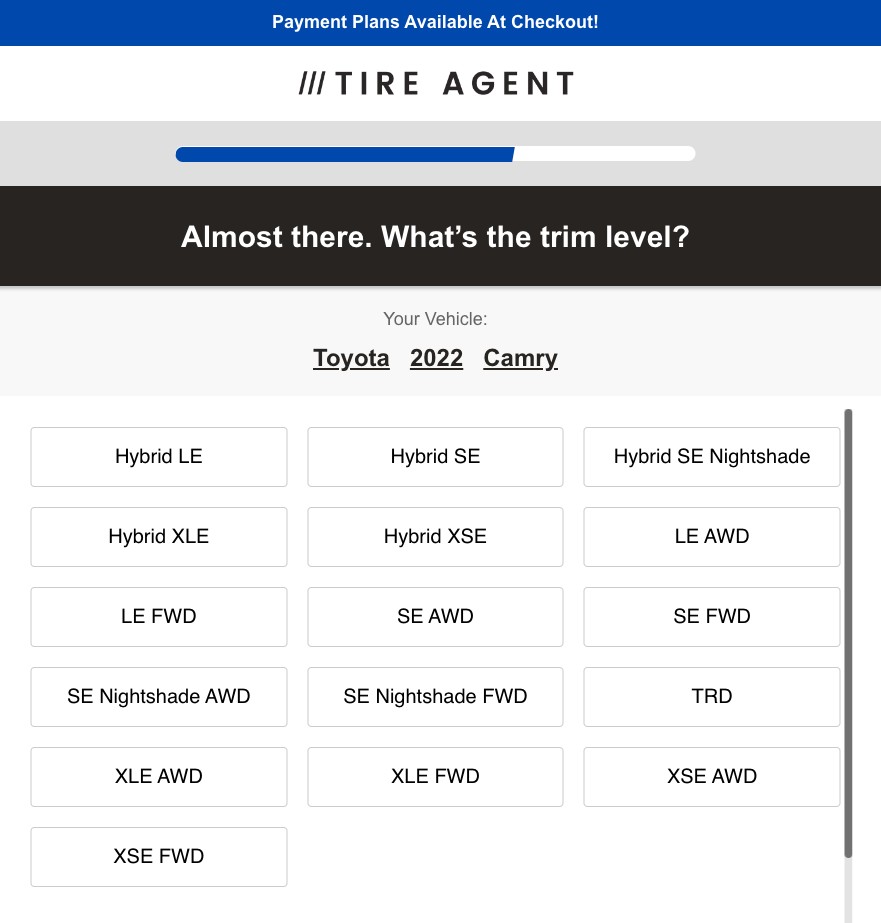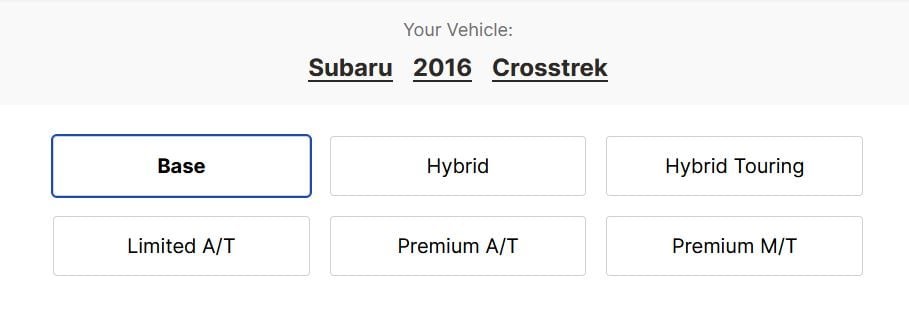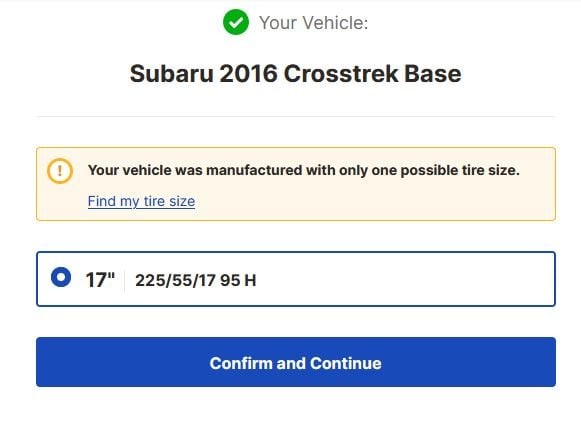Vehicle trim levels can be a confusing aspect of car buying and maintenance, yet they are crucial for ensuring vehicle compatibility and performance. When you’re browsing for a new car or even replacement parts like tires, you’ll often encounter terms like LE, SE, XLE, or TRD. These designations aren’t just random letters; they represent different “versions” or configurations of a specific car model, known as trim levels. For instance, while you might drive a Toyota Camry, the specific trim level, such as LE or XSE, dictates various features and specifications of your vehicle, including the appropriate tire size. Confirming your vehicle trim size is essential, especially before ordering tires online, as different trims can require different tire sizes.
Almost every car model available on the market comes with various trim options from the manufacturer. These trims are typically associated with different price points and feature sets, but importantly, your vehicle trim directly influences the correct tire size for your car. Choosing the wrong tire size due to neglecting the trim level is a common mistake, leading to returns and potential safety issues.
This article will thoroughly explain what vehicle trim levels are, how to easily find your vehicle’s trim, and why understanding your trim level is vital, particularly when it comes to tire selection. Knowing your trim level ensures you purchase the right tires and maintain your vehicle’s optimal performance and safety.
Decoding Trim Levels: What Does It Really Mean?
Vehicle trim levels are essentially different editions or versions within a specific car model lineup. When purchasing a vehicle, dealerships present various trim options that cater to diverse budgets and driving preferences. Manufacturers offer these trims to provide a range of features and functionalities within the same car model. You might find trims designated as hybrid, sport, luxury, or economy-focused versions, each offering a unique blend of characteristics.
The term “trim” in vehicle trim levels is not merely about aesthetics; it encompasses a range of vehicle features and specifications. Trim levels affect not only the visual aspects but also functional components such as engine size, interior materials, technology integrations, safety features, and even performance characteristics.
Consider the example of a Toyota Camry again. You might drive a Camry LE, while a friend owns a Camry TRD. Despite being the same car model, the difference in trim signifies a significant variation in features. While the Camry LE prioritizes fuel efficiency, offering better gas mileage (e.g., 28/39 city/highway MPG), the sport-oriented TRD trim emphasizes performance and driving dynamics with enhanced acceleration and handling. These differences extend to components like wheels and, crucially, tires.
| 2022 Toyota Camry LE (gas) | 2022 Toyota Camry TRD |
|---|---|
| Engine | 203-hp, 2.5-liter, 4 cylinders |
| Drivetrain | Front-wheel drive |
| Front wheel size | 17 × 7.5 in |
| Rear wheel size | 17 × 7.5 in |
| Front tire size | P215/55VR17 |
| Rear tire size | P215/55VR17 |
| Base curb weight | 3,310 lbs |





Car manufacturers intentionally specify different tire sizes for various trim levels to optimize vehicle performance and characteristics. Tires are not universal; they significantly impact a vehicle’s handling, fuel efficiency, ride comfort, and safety. A manufacturer might equip a specific trim level with larger tires to support heavier loads or enhance handling for a sport-tuned version. Conversely, other trims might utilize smaller tires to reduce costs or complement a lightweight, fuel-efficient design.
Why Trim Level is More Than Just Looks
Understanding your vehicle’s trim level is paramount because it represents fundamental differences beyond cosmetic enhancements. Trim levels reflect variations in materials, engineering, and overall vehicle design. Crucially, different trim levels necessitate different tire sizes, and using an incorrect tire size, even if seemingly close, can be detrimental and unsafe.
Incorrect tire sizes compromise vehicle safety and performance. Driving with tires not designed for your specific trim level or using mismatched tires can lead to discomfort, uneven tire wear, and unpredictable handling, creating a potentially dangerous driving experience. Furthermore, incorrect tire sizes can negatively impact fuel economy, reducing the efficiency of your vehicle.
Given the significant impact of trim level on your vehicle’s specifications, especially tire requirements, accurately identifying your car’s trim is essential for maintenance, repairs, and part replacements, especially when purchasing new tires.
Finding Your Car’s Trim Level – Your Guide
Locating your vehicle’s trim level is straightforward as manufacturers typically make this information readily accessible in several locations.
Here are common places to find your vehicle’s trim level:
-
Exterior Vehicle Markings: Often, manufacturers display the trim level designation on the car’s exterior, usually as a sticker, decal, or lettering. Look around the rear of your vehicle, near the trunk or tailgate, for these markings.
-
Owner’s Manual: Your vehicle’s owner’s manual is a comprehensive resource containing detailed information about your car, including the trim level. It will typically list the make, model, year, and specific trim information within the vehicle specifications section.
-
Vehicle Identification Number (VIN): The VIN is a unique identifier for your car and contains a wealth of information, including the trim level. Online VIN decoder tools, such as Decode the VIN, can decipher your VIN and provide details about your vehicle, including its trim.
-
Vehicle Registration Documents: Your vehicle registration documents, provided by your state’s Department of Motor Vehicles (DMV) or equivalent agency, often include the vehicle’s make, model, year, and sometimes the trim level.
-
Online Search: If you are unsure of your trim level, a quick online search using your car’s make, model, and year can often reveal the available trim packages for that specific vehicle. This is particularly helpful when researching potential car purchases or understanding the different options available for a particular model.
Using Your VIN to Identify Trim
The Vehicle Identification Number (VIN) is a 17-character code unique to your vehicle and acts as its fingerprint. It encodes crucial information about your car, including the manufacturer, year of manufacture, assembly plant, and, importantly, the trim level.
To use your VIN to find your trim level:
- Locate your VIN: The VIN is typically found in several locations on your vehicle (explained below).
- Use a VIN Decoder Tool: Visit a reputable online VIN decoder website. Many free VIN decoders are available; simply search for “VIN decoder” on any search engine.
- Enter your VIN: Input your VIN into the decoder tool and submit it.
- Retrieve Vehicle Information: The VIN decoder will process the VIN and display detailed information about your vehicle, including the trim level, along with other specifications.
Other Places to Locate Your Trim Level
Besides the VIN, you can find your VIN in these common locations:
- Sales Receipt: If you purchased your vehicle from a dealership, the sales receipt will definitively list the VIN.
- Dashboard Plaque: A visible VIN plaque is located on the driver’s side dashboard, near the windshield, viewable from outside the car.
- Doorjamb Sticker: Open the driver’s side door and look for a sticker on the doorjamb (the door frame). This sticker, often the manufacturer’s certification label, typically includes the VIN.
- Registration Papers: Your state-issued vehicle registration documents will always include the VIN.
Choosing the Right Tires Based on Trim Level
Ensuring you select the correct tire size for your vehicle’s trim level is crucial for safety and optimal performance. Here’s how to determine the right tire size:
-
Check the Tire Placard: The most reliable place to find your vehicle’s recommended tire size is on the tire placard or sticker. This is usually located on the driver’s side doorjamb or in the owner’s manual. The placard provides the original equipment tire size specified by the manufacturer for your trim level.
-
Consult Your Owner’s Manual: Your owner’s manual will also list the recommended tire sizes for each trim level of your vehicle model.
-
Use a Tire Matching Tool: Online tire retailers, like Tire Agent, offer tire matching tools. These tools allow you to input your vehicle’s make, model, year, and trim level to identify compatible tires. These tools simplify the process and ensure you find tires that fit your specific vehicle configuration.
When shopping for tires, using a tire matching tool and specifying your vehicle’s trim level ensures accuracy. While you can search for tires by size, starting with your vehicle’s details, including the trim, is the most reliable approach to guarantee compatibility.
Remember, wheel sizes are also trim-dependent. Tire matching tools often consider wheel compatibility as well, further simplifying the selection process.
Understanding vehicle trim levels is essential for car owners and buyers alike. By identifying your vehicle’s trim and using this information when selecting tires and parts, you ensure optimal vehicle performance, safety, and longevity. Tire Agent’s tire matching tool streamlines this process, helping you find the perfect tires for your car with ease and confidence. Explore our tire matching tool today and discover the right tires for your vehicle’s specific trim.
ID 40464520 | Stocksolutions | Dreamstime.com
